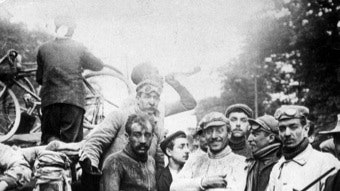Link: 2012 Summer Olympics – Nhat Meyer
Of this whole cool scene, my favorite moment was when we were all taking cellphone pictures at the same time of the divers entering the water. I was thinking – “I’m taking cellphone pictures with Kluetmeier and Burnett, how cool is that!”
Link: 2012 Summer Olympics – Al Bello
If I had to be critical I would say it was with TV and not London. THEY WERE EVERYWHERE!!!! You could not swing a dead cat without running into a TV person getting in the way of your shot. It was comical!! Don’t get me wrong, the TV guys were just doing their jobs and were also very nice but it was crazy how fast they jumped into your frame after every race, or every jubo. I don’t know if it will ever go backwards. It just keeps getting worse.
Link: 2012 Summer Olympics – Bob Deutsch
never be shooting pans at 1/20th of a second when your USA runner gets tripped up and crashes right in front of you in a 1500 meter final.
Link: 2012 Summer Olympics – David Eulitt
It’s commonplace for me to zone into just getting the pictures and miss the whole experience of sport. The communal witnessing of athletic greatness. The Olympics, perhaps the last place where national pride is demonstrated so passionately. How can that not be magic?
Link: 2012 Summer Olympics – Peter Read Miller
It was only several days later when the print magazine came out that one of our writers buttonholed me in the hall of the MPC and said “did you shoot that fencing picture in Sports Illustrated’s Leading Off?” I nodded. “Awesome!” he replied.
Link: 2012 Summer Olympics – Lucy Nicholson
I also set up to seven remote cameras covering different lanes and distances past the finish line. My main camera and all the remote cameras were connected to a foot switch with XLR cables and also to a server with Ethernet cables. Editor Michael Leckel was able to send my first photo to clients three minutes after the start of the men’s 100 meters.
Link: 2012 Summer Olympics – John Leyba
I don’t think getting in really close with a wide-angle lens makes any better photo than using 70-200. Not only the stills but also the TV. crew too. During gymnastics, the women’s team just got swamped with cameras in their face after winning the gold. We all looked at each other from the side and just watched. No photo to be had. Oh well. Whatcha gonna do?
Link: 2012 Summer Olympics – Paul Kitagaki
With 1,700 accredited photographers it’s quite a challenge trying to make a great story telling image. Long hours, ok food, but you have great camaraderie with fellow colleagues from the states. Everybody is trying to working at their top form, capturing the best performance and emotions of the athletes.
Link: 2012 Summer Olympics – David Bergman
While I literally have to pull an all-nighter to get these done, it’s absolutely worth it. I’ve always preached about “separating yourself from the pack” by doing something different from all the other photographers. I didn’t want to go back to the Olympics and stand next to 500 other shooters, with all of us trying desperately to make a photo that was 5 percent better. But this is a niche that I’ve spent years working on and the hard work has paid off. At least until I figure out the next thing.
Link: 2012 Summer Olympics – Mike Blake
when it came to shooting the athletes and them performing, it became very obvious that TV has been intently watching what we do as photographers because they were pretty much always where we wanted to be.














